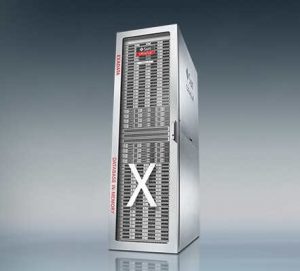Oracle Exadata X7 Delivers In-Memory Performance From Shared Storage
1.7PB of disk or 720TB of NVMe all-flash storage
This is a Press Release edited by StorageNewsletter.com on October 12, 2017 at 2:26 pmOracle International Corporation announced the next-generation Exadata X7 with hardware and software enhancements in overall performance, storage capacity, network bandwidth, and automation.

Exadata X7 delivers performance and reliability to run the large, most business-critical database workloads.
The Exadata is an engineered system designed to be the platform for all database workloads. It features scale-out, database optimized compute, IB networking, and storage for fastest performance and low costs. Specialized algorithms accelerate all types of database processing including OLTP, analytics, and consolidation. Exadata’s full-stack automation and optimization of all components slashes the need for skilled human labor, enabling reduced costs and improved reliability, data’s simplicity, scalability, and reliability make it the foundation for the recently announced Autonomous Database Cloud.
Today, Exadata powers four out of five of the wold’s biggest banks, telecoms, and retailers. Exadata can be deployed on-premises, in Oracle Cloud, or using the company’s Cloud at Customer.
Exadata X7 hardware features the latest Xeon Scalable processors and a 100% increase in the capacity of Exadata’s PCIe NVMe flash storage, plus a 25% increase in disk capacity. A ful rack Exadata X7 system has raw capacity of 1.7PB of disk storage or 720TB of NVMe all-flash storage.
Additionally, Ethernet network bandwidth has increased by 150% from 10 to 25Gb/s, while memory capacity and performance have increased by 50%. Overall, Exadata X7 database applications can realize 20 to 40% improvement in performance for OLTP, analytics and mixed workloads.
Exadata software
Exadata’s end-to-end software has the ability to coordinate and optimize application performance across database servers, networking, and storage. Because the company owns and controls the entire stack of Exadata hardware and software technologies, functionality has been tailored to recognize different application workloads, prioritize operations in real time, and run database queries in both compute and storage servers. Every Exadata release increases these advantages.
Also announced are Exadata software that extend the power of firm’s in-memory database technology to the large capacity of Exadata NVMe flash storage, enabling analytic workloads to achieve in-memory performance against large data sets in shared storage. With this, the same vector processing algorithms that make in-memory databases so fast in DRAM are applied to accelerate OLTP or analytic databases by automatically creating a columnar formatted cache in Exadata flash storage, boosting analytics by up to 400%.
The Exadata software also delivers in-memory performance from shared storage for OLTP workloads. It automatically uses DRAM as a cache in storage to speed-up access to data by up to 250%, as compared to already-fast flash access times. Algorithms automatically coordinate between database server and storage server memory caches to avoid redundant caching of the same data. This feature cannot be implemented by conventional storage.
“Exadata continues to innovate faster than any other database or storage platform,” said Juan Loaiza, SVP, systems technology, Oracle. “Exadata’s scale-out, smart storage architecture was the first to support PCI/NVMe flash in 2014, with Exadata X5, the first to offload database queries to storage and the only platform to deliver in-memory performance from shared storage for OLTP and Analytics. Exadata is the only database platform to have on-premises, public cloud and Cloud at Customer deployment options.”
Resources:
Exadata X7
Exadata Database Machine X7-2 DS













 Subscribe to our free daily newsletter
Subscribe to our free daily newsletter

